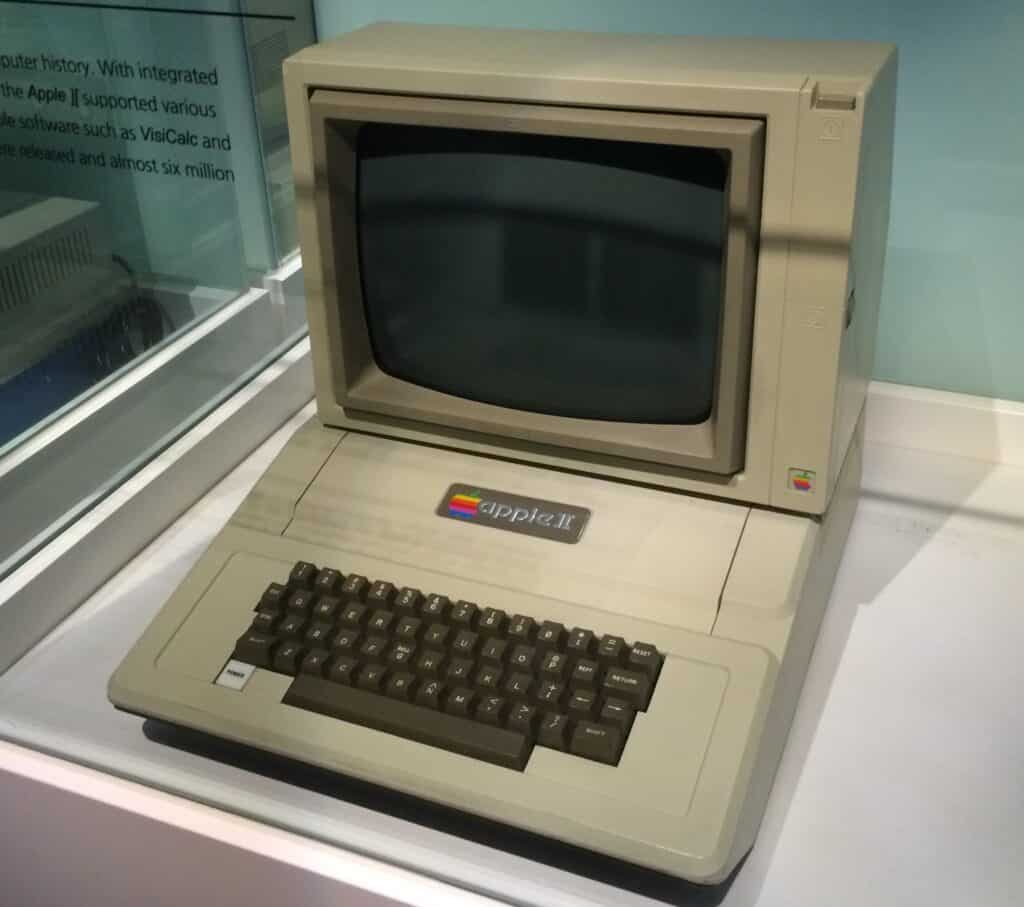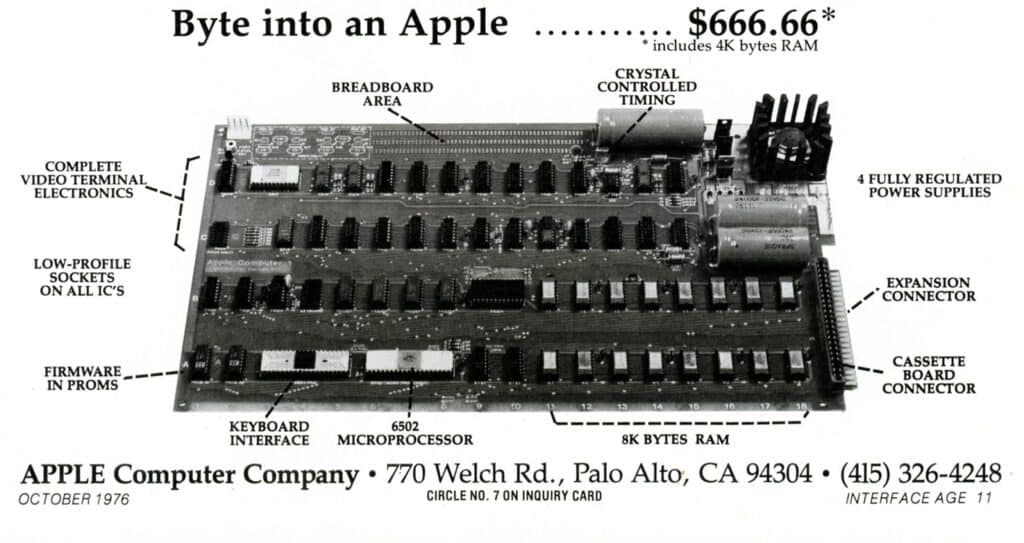The claim
The bitten apple in the Apple logo is a reference to Alan Turing, who committed suicide with a poisoned apple.
Our conclusion
The Apple logo has nothing to do with Alan Turing. This story was added later. The reasons for the design are somewhat more banal.
Alan Mathison Turing was a pioneer of computer science and computer development. During the Second World War he cracked the encryption of German radio messages (Enigma), developed one of the first chess computers and is considered a pioneer of artificial intelligence (Turing test). Persecuted because of his sexuality in England in the 1950s, he had to undergo hormone treatment and developed depression. His tragic death in 1954 still raises questions. The police at the time assumed it was a case of suicide by means of a poisoned apple.
In 1976, Steve Jobs founded the company Apple together with two colleagues from a computer club. Her first home computer was still a hobbyist piece with a wooden case. But the gray casing of the Apple II from 1977 was already adorned with a logo that is now considered the most valuable brand in the world: the bitten apple in rainbow colors. Especially in the LGBT community, people added 1 + 1 together and drew the obvious conclusion: the Apple logo alludes to the death of Alan Turing.
Alan ended his own life on June 7, 1954. He spiked an apple with cyanide and ate a bite of it. He did this because the British government chemically castrated, humiliated and persecuted him for being gay.
Alan is the reason why a piece has been bitten out of the Apple logo - in honor of Alan Turing.
So what did he do? He invented computer science and used his first drafts to decipher the Enigma code - the machine encryption that the Nazis and the German military used to transmit secret orders to each other during World War II - saving millions of lives and bringing us into the modern age of Computer science led.
Pride Month isn't just about dancing on floats in gold hot pants or flying a rainbow flag. It's about remembering that everyone has the right to be happy, to love who they want to love, and to recognize the outstanding contribution that everyone can make in a society without fear and prejudice.
The inspiring original English text by Bobby Waters on Facebook has been shared and copied hundreds of thousands of times, including in other languages and on other platforms .
Bobby Waters certainly wasn't the first to propose or at least popularize this theory. But he has contributed massively to its spread via social media. The problem: it's wrong. Water's posting went viral on June 30, 2022, so much so that Snopes published a fact check on the same day. Snopes verdict: mostly correct. All statements about Turing are correct, but the key detail about the connection to the Apple logo? Incorrect.
The story behind the Apple logo
Before we take a look at the logo design, let's briefly talk about the name of the company. There are also some modern myths surrounding this. One of them is the apple that is said to have fallen on Newton's head. Or the fruit from the biblical tree of knowledge that Eve passed on to Adam. Both are nice stories, but Steve Jobs confirmed in an old video interview that the reasons were much more banal: “Firstly, because I really like apples, and secondly, because Apple is ahead of Atari in the phone book and I used to work for Atari have."
And what about the Apple logo? Ronald Wayne's first draft was quite complicated and in the style of a baroque engraving: Isaac Newton under an apple tree. The accompanying slogan “Newton… A Mind Forever Voyaging Through Strange Seas of Thought… Alone” is no less complex. Steve Jobs was against it and Apple co-founder Ron Wayne was only with the company for eleven days anyway.
Rob Janoff drew the second draft. He had a very free hand. Steve Jobs' only rule was: “Don't make it cute.” The result: the bitten apple (and a second version without a bite mark, in case that would be too “cute”) in different versions: plain, metallic and with colored stripes. The version with the color strips turned out to be the best, because the Apple II was supposed to have a color monitor.

In a interview with Rob Janoff, he tells the full story behind the logo design. The bitten apple is not an allusion to the computer term byte (the homonym bite means bite). Newton and Eva had nothing to do with it either. And the Turing connection?
I heard that one of the legends says that the colored logo is a tribute to him. People think I did the colored stripes because of the gay flag. And that was something I thought about for a really long time. The other really cool part was that he apparently killed himself with an apple laced with cyanide. And then I found out that Alan Turing's favorite childhood story was Snow White, in which she falls asleep forever after eating a poisoned apple and is woken up by the handsome prince. […]
I designed it with a bite as a measure of scale so that people understand that it is an apple and not a cherry. Plus, biting into an apple was somehow symbolic. Something everyone can experience. This applies to all cultures. If anyone has ever eaten an apple, they have probably bitten into it and this is what you get.
Rob Janoff in an interview with CreativeBits, 2009
Even though the pun on byte was initially unintentional and purely coincidental, it was immediately used to market the Apple I. An earlier version of this ad did not include the slogan “Byte into an Apple.”

On the trail of an urban legend
So the connection between Turing and the Apple logo is incorrect. But where does the idea come from? Who knew the details of Turing's tragic death? Many people. The film Enigma (2001) tells the story of the code breakers in Bletchley Park, England. And the later blockbuster The Imitation Game (2014), starring Benedict Cumberbatch, is based directly on the life of Alan Turing.
The most famous actual resident of Bletchley Park was the infamous mathematical genius Alan Turing (also considered the father of computers that even inspired Apple computer's logo with his morbid suicide from an arsenic laced apple), but he's not a part of this particular bit of history mixed with romanticism- “he would have required an entire other film” director Michael Apted informed.
Film critic Emily Blunt on Enigma
The Imitation Game is based on the biography Alan Turing: the enigma by Andrew Hodges (1983). The book speculates about Turing's suicide and connects it to the apple scene from the Disney film Snow White. The film only hinted at this ending. The scenes that had already been shot showing the suicide and the discovery of the body ultimately fell victim to the editing. Even though director Morten Tyldum avoided the bitter ending, many people wanted to know what really happened to Alan Turing. At a talk event, Benedict Cumberbatch first explained the original ending and then the one that made it into the theatrical version:
He walks in the door frame and looks at the machine, which is the embodiment of the love of his life, Christopher. He smiles, and in my mind, what I was saying was, 'I'm coming to see you now.' He turns off the light, walks into the darkness, and that's it. That's what you see. I thought [Tyldum] was spot-on in his judgment of that.
Benedict Cumberbatch in November 2014 at 92Y, New York
The fact that some people were familiar with Hodges' Turing biography long before both films is shown by a passage from Sadie Plant's book Zeros and Ones (1997). This is also the oldest written source of the urban legend that we could find:
Two years later he was dead. The coroner declared suicide, but his mother was convinced it was an accidental death: she always told him to wash his hands when he played with cyanide. “There was half an apple next to the bed, which he had bitten into several times. And this strange story doesn't end there. Rainbow logos with Turing's missing bytes can be seen on every Apple Macintosh computer.
By the way: It is extremely unlikely that the American students Steve Jobs and Steve Wozniak even knew about Alan Turing in 1976. The fact that the British had managed to crack the Enigma code only became public knowledge in the mid-1970s. Even in Britain, no one knew Turing at the time. Long before the internet, details about a person from British military history and in America? That just doesn't work.
Conclusion
A nice story, but unfortunately just a legend. The actor Stephen Fry once asked his good friend Steve Jobs directly whether it was true that the Apple logo alludes to Alan Turing. His response: “It’s not true, but God, we wish it were!”
More apple stories? Apple overtakes Google Street View
Notes:
1) This content reflects the current state of affairs at the time of publication. The reproduction of individual images, screenshots, embeds or video sequences serves to discuss the topic. 2) Individual contributions were created through the use of machine assistance and were carefully checked by the Mimikama editorial team before publication. ( Reason )


